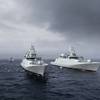Australia’s amphibious capability was put to the test recently as the Amphibious Task Group Headquarters took charge of the largest amphibious assault conducted by an Australian force for 70 years as part of Exercise TALISMAN SABER.
The assault, led from amphibious sssault ship HMAS Canberra, was a significant milestone in the Australian Defence Force’s development of a high end amphibious warfare capability.
The Australian and New Zealand Amphibious Ready Group, consisting of HMA Ships Canberra and Choules and the Royal New Zealand Navy’s HMNZS Canterbury, landed 600 embarked personnel, predominantly consisting of the Australian Army's 2nd Battalion, the Royal Australian Regiment, as part of a flanking force for the US Marine Corps’ 31st Marine Expeditionary Unit.
For Canberra, participation reinforced the ship’s utility as a key component of future Australian Defence Force operations.
Chief of Joint Operations Vice Admiral David Johnston said Australia's geographic location made amphibious operations a key capability requirement.
"We live on an island and in a maritime environment, and this influences the nature of work the Australian Defence Force is called on to support," Vice Admiral Johnston said.
"That work might be a humanitarian assistance activity such as Operation FIJI ASSIST in 2016, which was a demonstration of why amphibious capability is essential to enabling us to support our neighbours when they need our help.
“Or it might be the conduct of combat operations as directed by Government.
"Amphibious capabilities are inherently flexible and allow us to operate in peacetime roles and war time roles.
“That's why we need it, and why we practice it," Vice Admiral Johnston said.
Chief of Navy Vice Admiral Tim Barrett said the training to progress towards full certification of the ships.
"This opportunity to operate alongside other amphibious vessels from our own Fleet as well as from foreign navies is essential for us to be able to certify the amphibious ready group," Vice Admiral Barrett said.
"We're doing well so far - there's a great group of people onboard HMAS Canberra and both the ship's company and embarked Army, Navy and Air Force elements are working together very well.
"Practicing a combined force entry operation like this is greatly beneficial to us in this phase, when we're proving the concepts and the ability for the Australian Defence Force to put all of this together working with our international partners.
“This is essential to amphibious operations," Vice Admiral Barrett said.













